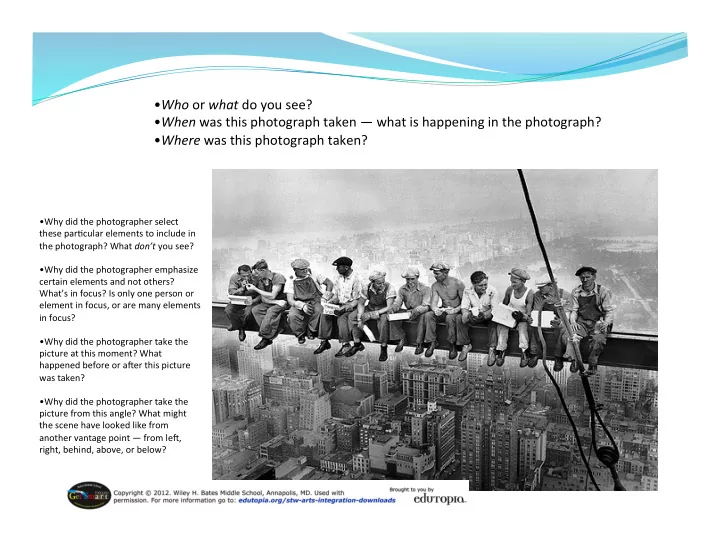

• Who ¡or ¡ what ¡do ¡you ¡see? ¡ • When ¡was ¡this ¡photograph ¡taken ¡— ¡what ¡is ¡happening ¡in ¡the ¡photograph? ¡ • Where ¡was ¡this ¡photograph ¡taken? • Why ¡did ¡the ¡photographer ¡select ¡ these ¡par8cular ¡elements ¡to ¡include ¡in ¡ the ¡photograph? ¡What ¡ don’t ¡you ¡see? ¡ ¡ • Why ¡did ¡the ¡photographer ¡emphasize ¡ certain ¡elements ¡and ¡not ¡others? ¡ What’s ¡in ¡focus? ¡Is ¡only ¡one ¡person ¡or ¡ element ¡in ¡focus, ¡or ¡are ¡many ¡elements ¡ in ¡focus? ¡ • Why ¡did ¡the ¡photographer ¡take ¡the ¡ picture ¡at ¡this ¡moment? ¡What ¡ happened ¡before ¡or ¡a@er ¡this ¡picture ¡ was ¡taken? ¡ • Why ¡did ¡the ¡photographer ¡take ¡the ¡ picture ¡from ¡this ¡angle? ¡What ¡might ¡ the ¡scene ¡have ¡looked ¡like ¡from ¡ another ¡vantage ¡point ¡— ¡from ¡le@, ¡ right, ¡behind, ¡above, ¡or ¡below?
The POWER OF THE Photographic Composition Principles ¡of ¡Design ¡and ¡ Elements ¡of ¡Art ¡ ¡ are ¡used ¡ making ¡ photographs ¡– ¡ not ¡ just ¡taking ¡ photographs. ¡ The ¡different ¡arrangements ¡– ¡ or ¡ compositions ¡the ¡ photographer ¡selects-‑ ¡ creates ¡artistic, ¡interesting, ¡ more ¡visually ¡powerful ¡ photographs. ¡
Rhythm/ ¡ Balance ¡ Contrast ¡ Repetition ¡ Emphasis ¡ Symmetrical ¡ Opposites ¡ Repeating ¡ ¡ Focal ¡Point ¡ Asymmetrical ¡ Differences ¡ shapes ¡and ¡ Radial ¡ ¡ colors ¡
This ¡photograph ¡shows ¡the ¡following ¡elements ¡and ¡principles: ¡ color, ¡contrast, ¡ emphasis, ¡and ¡value. ¡ ¡Value ¡is ¡shown ¡through ¡the ¡different ¡shades ¡of ¡the ¡color ¡ orange ¡and ¡hues ¡that ¡are ¡bright ¡and ¡really ¡stand ¡out ¡from ¡each ¡other. ¡Contrast ¡ is ¡used ¡in ¡the ¡variation ¡between ¡the ¡light ¡colors ¡(red, ¡orange, ¡yellow) ¡and ¡the ¡ dark ¡colors ¡(black, ¡dark ¡blue-‑violet, ¡and ¡brown). ¡Emphasis ¡is ¡used ¡in ¡this ¡ photograph ¡by ¡the ¡two ¡dark ¡blue-‑violet ¡berries ¡hanging ¡on ¡the ¡leaf ¡near ¡the ¡ center. ¡
EMPHASIS ¡or ¡Focal ¡Point ¡ Emphasis in a composition refers to developing points of interest to pull the viewer's eye to important parts of the body of the work. This can be achieved with element of simplicity. ¡
Balance is a sense of stability in the body Balance ¡ of work. Balance can be created by repeating same shapes and by creating a feeling of equal weight. ¡ ¡ Symmetrical ¡ Asymmetrical ¡ Radial ¡ ¡
CONTRAST ¡ Contrast refers to the opposites and differences in the work. You can achieve variety by using different shapes, textures, colors and values in your work. ¡ ¡
Repe88on ¡and ¡Rhythm ¡ Rhythm is a type of movement in drawing and painting. It is seen in repeating of shapes and colors. Alternating lights and darks also give a sense of rhythm. ¡
Movement ¡ Movement adds excitement to your work by suggesting action or direction ( providing a path for our eyes to follow ) when we look at a work of art. ¡
Contrast ¡ Can ¡you ¡ Opposites ¡ match ¡the ¡ Differences ¡ Principle ¡ to ¡the ¡ photo? ¡ Rhythm/ ¡Repetition ¡ Repeating ¡ ¡shapes ¡and ¡colors ¡ Emphasis ¡ Balance ¡ Focal ¡Point ¡ Symmetrical ¡ Asymmetrical ¡ Radial ¡ ¡ Movement ¡ Providing ¡a ¡path ¡for ¡eyes ¡to ¡follow ¡
It’s ¡YOUR ¡turn! ¡ ¡ ¡ ¡ Tell ¡a ¡math ¡story ¡through ¡ PHOTOGRAPHY ¡ ¡ Use ¡the ¡principles ¡of ¡design ¡to ¡compose ¡a ¡ Photo ¡Story. ¡ Rhythm/ ¡ Balance ¡ Repetition ¡ Contrast ¡ Symmetrical ¡ Emphasis ¡ Opposites ¡ Repeating ¡ ¡ Focal ¡Point ¡ Asymmetrical ¡ Differences ¡ shapes ¡and ¡ Radial ¡ ¡ colors ¡ Photographs ¡are ¡not ¡simply ¡randomly ¡'taken' ¡but ¡are ¡ in ¡fact, ¡'crafted' ¡using ¡skills ¡of ¡exposure ¡and ¡light ¡ selection ¡as ¡well ¡as ¡ compositional ¡ skills. ¡Images ¡ are, ¡therefore, ¡composed ¡in ¡order ¡to ¡tell ¡a ¡story. ¡
Recommend
More recommend